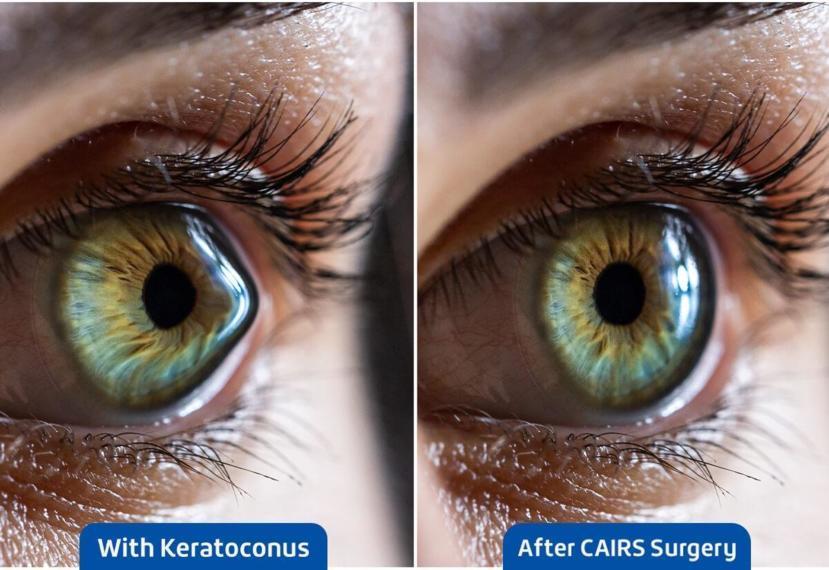CAIRS for Keratoconus: A New Hope for Clearer Vision

Alex James is a top Health and Wellness Coach in New York, State. With a passion for the field and an unwavering commitment to their specialty, Alex James is an expert in changing the lives of their patients for the better. Through their designated cause and expertise in the field, Alex James is a prime example of... more
Keratoconus is a progressive eye disease that affects the cornea, the clear, dome-shaped front surface of your eye. In keratoconus, the cornea thins and gradually bulges into a cone-like shape. This irregular shape distorts vision, causing blurriness, glare, light sensitivity, and often significantly impacting daily life.
For many years, treatment for keratoconus focused on managing symptoms with specialized contact lenses, or, in advanced cases, corneal transplantation. While corneal cross-linking (CXL) has been a game-changer in halting the progression of the disease, it doesn't always improve the existing corneal shape or visual acuity to the desired extent. This is where a revolutionary procedure called CAIRS is offering new hope.
What is CAIRS? (Corneal Allogenic Intrastromal Ring Segments)
CAIRS stands for Corneal Allogenic Intrastromal Ring Segments. This innovative surgical technique involves implanting precisely shaped segments of donor corneal tissue (allogenic) into the middle layer (stroma) of the patient's own cornea. Think of these segments as tiny, biocompatible arcs that are strategically placed to gently reshape and regularise the distorted keratoconic cornea.
Unlike older procedures that used synthetic rings (Intacs), CAIRS utilizes human donor corneal tissue. This is a significant advantage as it promotes better biocompatibility and reduces the risk of complications associated with synthetic materials.
How Does CAIRS Work?
The CAIRS procedure is typically performed using a femtosecond laser to create precise tunnels within the corneal stroma. These tunnels are custom-designed based on the individual patient's corneal topography and the severity of their keratoconus. Once the tunnels are created, the allogenic corneal ring segments are carefully inserted.
By acting as an internal "splint," these segments exert a gentle pressure that flattens the steepest part of the cone and moves the apex of the cornea towards the center. This reshaping effect leads to a more regular corneal surface, which in turn improves how light focuses on the retina, leading to better vision.
Key Benefits of CAIRS for Keratoconus Patients
CAIRS offers several compelling advantages as a keratoconus treatment for individuals living with the disease:
- Improved Visual Acuity: One of the most significant benefits is the potential for improved uncorrected and corrected vision. By regularising the corneal shape, CAIRS can reduce astigmatism and myopia, often leading to better visual outcomes than what was achievable with contact lenses alone.
- Enhanced Corneal Stability: While CXL primarily halts progression, CAIRS can contribute to greater corneal stability by adding structural support.
- Reduced Reliance on Contact Lenses: For many patients, CAIRS can reduce their dependence on rigid gas permeable (RGP) or scleral contact lenses, or even eliminate the need for them entirely.
- Minimally Invasive: Compared to a full corneal transplant, CAIRS is a less invasive procedure with a faster recovery time.
- Biocompatible Material: The use of allogenic (human donor) tissue minimizes the risk of rejection and promotes better integration with the native cornea.
- Reversibility (in some cases): Unlike some other corneal procedures, the CAIRS segments can potentially be removed if necessary, although this is rare.
Who is a Candidate for CAIRS?
CAIRS is generally considered for patients with progressive keratoconus who:
- Have intolerance to contact lenses or poor vision with contact lenses.
- Are not suitable for a full corneal transplant or wish to defer it.
- Have clear central corneas without significant scarring.
- Have sufficient corneal thickness to safely create the stromal tunnels.
Your ophthalmologist will perform a thorough evaluation, including corneal topography and pachymetry (corneal thickness measurement), to determine if you are a suitable candidate for CAIRS.
What to Expect
The CAIRS procedure is typically performed under local anaesthesia as an outpatient procedure. Recovery is generally well-tolerated, with most patients experiencing some mild discomfort and blurred vision in the initial days. Vision gradually improves over several weeks to months as the eye heals and adapts to the new corneal shape. Regular follow-up appointments with your surgeon are crucial to monitor your progress.
A Promising Advance
CAIRS represents a significant step forward in keratoconus treatment, particularly for those seeking to improve their vision beyond what contact lenses can offer, or to potentially delay or avoid a corneal transplant. If you have keratoconus and are exploring your treatment options, discuss CAIRS with your ophthalmologist. It may be the key to unlocking a clearer future.









